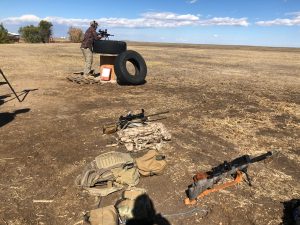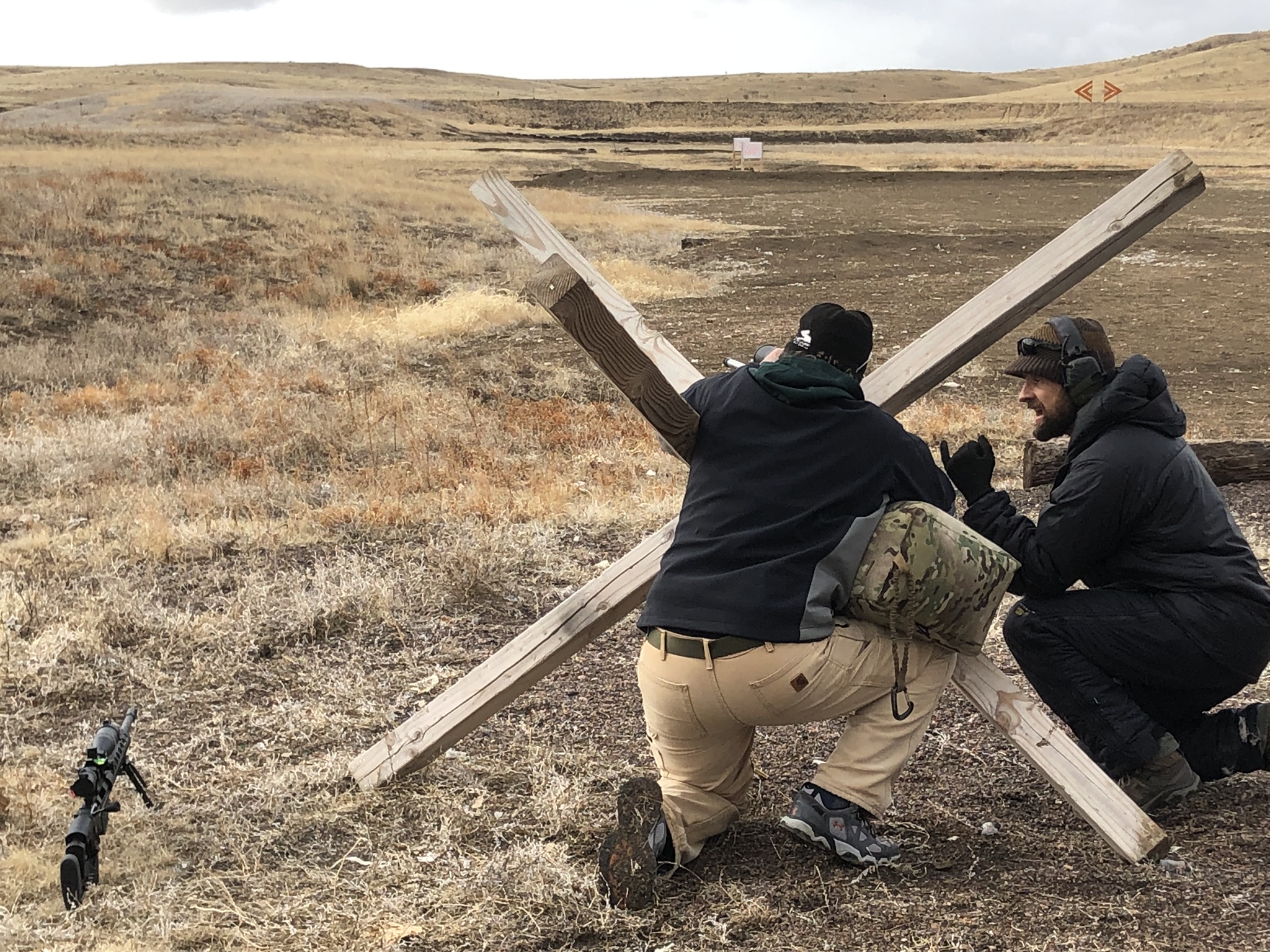By Joden Seiders, 16 Jan 2019
Loved it. Freakin loved it. As a hunter that likes getting up close and personal with a bow, as well as harvest my game from long distance during rifle season, refining those skillsets is a full time commitment if you want to be efficient. Maybe if I dropped archery hunting or rifle hunting and focused on one it would not be full time, however, I am not going to do that because I am a hunter first. I love every aspect of hunting. Right now in my life, competition comes second, although a very close second. Regarding precision rifle competitions, there is no better way to be productive with your time if you want to improve long-range confidence then competing in a precision rifle match. Now to be clear, I am not talking about a bench rest match involving laying prone or shooting from a table. I am talking awkward positional shooting. Although there is some prone involved, typically with the longer distances or very small targets at medium distance, 90% of the first match I experienced was awkward positions using fat bags, barricade bags and a combination of both.
First stage I was the only one to clean the whole thing within the time in my particular group. It was a prone know your limits (KYL) and it was a healthy start for my first match. I walked to the second stage thinking this is not as hard as I thought. Wrong. The entire rest of the match I blew it out of my ###. Next stage was shooting at two different targets while switching between four different shooting positions ranging from kneeling to that awkward 18” off the ground where it’s too high to lay prone and too low to kneel comfortably. While kneeling, you used a fat bag to close the gap between your knee and the buttstock. Using the least amount of muscle and more structural support is the key. In one stage the shooter shot from four different positions from a barricade using their dominate hand, and then shot those same positions off-hand. This was obviously a weakness among many of the shooters; surprisingly this was one of my better stages, not great but OK.
 Another stage involved four target (350, 450, 550, and 650) using only holds. The rules restricted you to dial for one of four ranges and hold for the rest. This is another stage where I made a rookie mistakes. I dialed for 350, and then held for the rest using my exact dope that the ballistics calculator gave me. What I did not consider was subtracting the 1.1mils that I dialed for 350y from the rest of the ranges. Therefore, if 450y called for 1.7 mils I should have taken the 1.1 mils required for 350y out of the 1.7 mils, which would have been a .6 mil holdover for the 450y target. See Table 1 for some quick math that should be done prior to the stage.
Another stage involved four target (350, 450, 550, and 650) using only holds. The rules restricted you to dial for one of four ranges and hold for the rest. This is another stage where I made a rookie mistakes. I dialed for 350, and then held for the rest using my exact dope that the ballistics calculator gave me. What I did not consider was subtracting the 1.1mils that I dialed for 350y from the rest of the ranges. Therefore, if 450y called for 1.7 mils I should have taken the 1.1 mils required for 350y out of the 1.7 mils, which would have been a .6 mil holdover for the 450y target. See Table 1 for some quick math that should be done prior to the stage.
Table 1.
| Range | Uncorrected Hold in mils | Corrected Holdover | ||
| 350y | 1.1 | POA/POI | ||
| 450y | 1.7 | 1.7 – 1.1 | = | .6 |
| 550y | 2.4 | 2.4 – 1.1 | = | 1.3 |
| 650y | 3.2 | 3.2 – 1.1 | = | 2.1 |
So for the holder over stage the range card on the side of the gun or arm coach should have looked like this:
| .6 |
| 1.3 |
| 2.1 |
Precision Rifle Competition as it relates to the SOF community
Very simple stuff, in my previous years as a sniper I should have known better. That being said, new environments typically cause the simplest of mistakes. In addition, in the SOF community we do limited positional shooting. Should the SOF community focus more on it? Let’s consider some stuff. We train to shoot from different positions but do not have the time to become positional experts because of other skillsets required of a SOF operator. Prioritization. Most importantly, we set up sniper hides to hunt human beings; we do so with stable positions if possible. We are not just pinging steel, we are not trying to wound (although an effective tactic used to inflict more casualties), we’re simply trying to kill the enemy. Therefore, a stable position that is held for hours usually in horrible conditions is preferred. In addition, some positions in the precision circuit are not tactically advantageous.
As it related to Long Range Hunting
Back to being a long-range hunter. Precision matches in my opinion are the quickest way to become a proficient shooter. I recently listened to a podcast that discussed a sheep hunter in Wyoming that saved preference points for years to get a tag. In 2018, he finally drew a bighorn sheep tag. While hunting he and the guides found a sheep at a decent distance, don’t remember exactly, but long enough it resulted in a missed opportunity with no shots attempted because the hunter was scavenging the hillside for a good spot to shoot prone. One of the guides who had experience with precision rifle competitions said that if the hunter had the knowledge and confidence shooting with supporting sticks on the front and/or rear of the gun, which is a common precision match problem set, he would have made a fairly easy shot. Now to throw myself under the bus, I’m guilty as charged as well. This last spring on my 2018 Montana BB hunt I spotted a bear at 1500y, I closed the distance to just over a thousand yards. Then for five minutes, I frantically rummaged the hillside for a prone position because I didn’t have the shooting sticks with me AND I didn’t have experience shooting at anything over 600y in with the shooting sticks anyways. My honest assessment, If I had the sticks with me I might have convinced myself that I had a stable enough position to attempt a shot, very likely missing or worse, wounding the bear. Needless to say, I was lucky in that in the 5 minutes it took me to make a prone firing position, which involved digging into the hillside under the butt of the gun in order to level it out, the bear was taking his time lolly-gagging up the opposite hillside, affording me a shot. As a hunter, you cannot count on having that kind of time.

In Conclusion
Bottom line, the more you practice shooting in sitting, kneeling, and awkward prone positions, the more comfortable and confident you will be in making an ethical long range shot in a short amount of time. Hunting is already challenging enough as it is, hunters know that
opportunities come and go incredibly fast. There is already enough outside stressors that effect you negatively i.e., increased heart rate, heat, cold, sweat, wind, and equipment malfunctions. Let’s not mention the time required to range the target, adjust parallax, dial scope, and make a wind call prior to pulling the trigger (and these are the least amount of steps if you are using a rangefinder with built in ballistics like the KILO2400. If you’re using a rangefinder without a ballistic solution and a Kestrel or phone app, you have added steps for ranging and looking up the range. What can we as precision hunters work on? Trigger time in different positions and environments that are encountered in precision competitions. Probably the largest benefit of competing is the amount of knowledge and experience that is gathered in one place. You will learn new ways to use the gear you have as well the gear you want in order to take you to the next level. Piece of advice, don’t buy any gear before attending a match. Attend one, try other peoples gear, and then buy what works for you based off experience. In fact attend a couple before buying your own stuff. Update: I wrote this article a few months back but never published it until now, since this match, I have competed a few times and learned a lot about utilizing gear to solve the awkward positional shooting problem sets in a match and fundamentals of competing; I’ve also learned that I have a lot more learning to do!
Backcountry Precision
Blood. Sweat. Reward


https://shorturl.fm/PFOiP
https://shorturl.fm/TDuGJ
https://shorturl.fm/eAlmd
https://shorturl.fm/fSv4z
https://shorturl.fm/nqe5E
https://shorturl.fm/I3T8M
https://shorturl.fm/VeYJe
https://shorturl.fm/FIJkD
https://shorturl.fm/YvSxU
https://shorturl.fm/j3kEj
https://shorturl.fm/a0B2m
https://shorturl.fm/oYjg5
https://shorturl.fm/68Y8V
https://shorturl.fm/TbTre
https://shorturl.fm/A5ni8